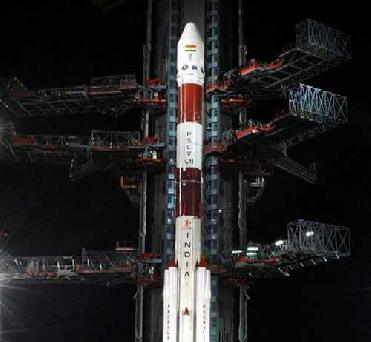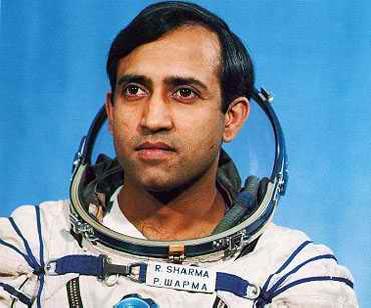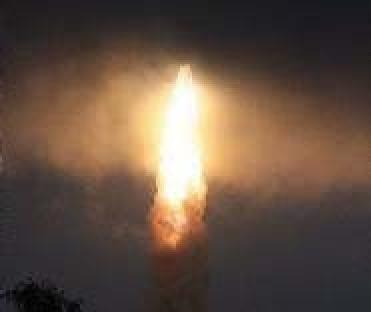
Chandrayaan-1, on the launch pad at the Satish Dhawan Space Centre in Sriharikota. PTI Photo
SRIHARIKOTA (PTI): With the final countdown progressing without any hitch today, India's maiden unmanned moon mission--Chandrayaan-1-- is all set to lift off tomorrow to launch a two-year space odyssey that will catapult the country into an exclusive club of moon-faring nations.
The weather conditions over the Sriharikota spaceport were being closely monitored and officials said there is no chance of the launch being postponed unless a cyclonic threat emerged. The polar rocket that will put the spacecraft into lunar orbit was being fuelled.
"Everything is going in order. We are ready to launch on the dot," a space official said, as hundreds of scientists went through the 49-hour countdown drill with precision.
The 1,380 kg spacecraft would be put into orbit by India's homegrown rocket PSLV-C11, which is due to blast off at 6.20 am tomorrow from the second launch pad at Satish Dhawan Space Centre (SDSC).
The work on filling of propellant for the first stage of the polar launch vehicle had been completed and the second stage filling would be over tonight, SDSC Associate Director Dr MYS Prasad told PTI here, 80 km north of Chennai.
"The countdown, which started at 5.22 am yesterday, is progressing smoothly and the propellant filling of PS-2 (first stage) has been completed," he said adding a total of about 43 tonnes of propellant would be filled.
Asked about weather conditions in this spaceport town, which is witnessing isolated rains, Prasad said the rains would not affect the launch. "The rain does not matter as the spacecraft is fully rain proof. Even if it is drenched, the launch would take place as per schedule."
However, the launch might have to be rescheduled if there were cyclonic weather conditions, he added.
Chandrayaan-1 would put India in the elite lunar club comprising Russia, US, Japan, China and European Space Agency, who had undertaken unmanned exploratory missions to the moon. The mission intends to put an unmanned spacecraft into an orbit around the moon and to perform remote sensing of the nearest celestial neighbour for about two years with eleven payloads (scientific instruments).
It would reach the moon surface in the second week of November. Later, the moon impact probe would be ejected from Chandrayaan-1 over the moon surface in a chosen area.
Following this, cameras and other scientific instruments would be turned on. This would lead to the operational phase of the mission. This phase lasts about two years during which Chandrayaan-1 would explore the lunar surface with its array of instruments that include cameras and spectrometers.
The solar-powered Chandrayaan-I, carrying 11 payloads, weighs about 1,380 kg at the time of its launch and is shaped like a cuboid with the solar panel projecting from one of its sides.
Of the eleven payloads, five are entirely designed and developed in India, three from European Space Agency, one from Bulgaria and two from the US.
Chandrayaan-1 aims to achieve scientific knowledge through high-resolution remote sensing of moon in the visible, near infrared, microwave and x-ray regions of electromagnetic spectrum. With this, preparation of a three-dimensional atlas of the lunar surface and chemical and mineralogical mapping of entire moon surface was envisaged.
 Previous Article
Previous Article Next Article
Next Article













The Indian Air Force, in its flight trials evaluation report submitted before the Defence Ministry l..
view articleAn insight into the Medium Multi-Role Combat Aircraft competition...
view articleSky enthusiasts can now spot the International Space Station (ISS) commanded by Indian-American astr..
view article